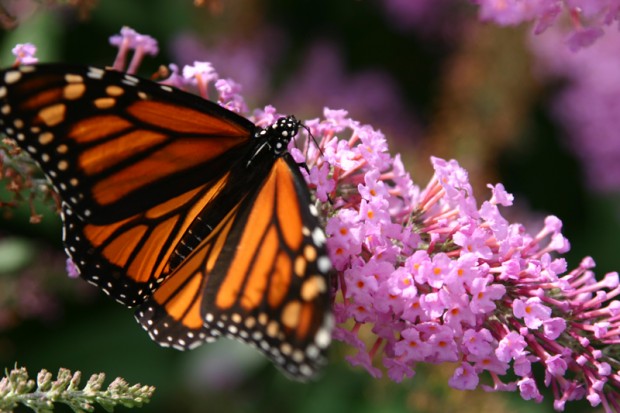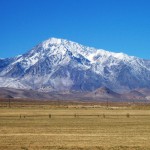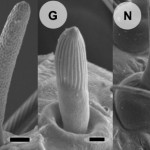Dressed in orange and black, they have traveled epic distances, through the unforgiving environs of urban development, only to arrive with feverish anticipation for what’s to come.
Who are these eager travelers? Legions of kids flooding into Natural Bridges State Beach in Santa Cruz, Calif. to view the return of migrating Monarch butterflies.
Every autumn, all the monarchs west of the Rocky Mountains head to California to escape the cold of the oncoming winter at the their regular homes. Those east of the Rockies make an even longer journey, from as far north as Canada to central Mexico where they overwinter in oyamel fir trees.
Santa Cruz’s “Welcome Back Monarch Day” festival, held this year on Oct. 13, is a picturesque scene with handmade ice cream, folk bands, and kids donning paper butterfly wings with orange and black face paint. The monarchs flock to Natural Bridges for its grove of eucalyptus trees, and in the mid-afternoon, as the sun bakes their leaves, the air fills with a crisp cloud of minty aroma.
But the future of this epic journey and its collateral ecotourism are clouded with uncertainty.
Scenes From Monarch Day
Though monarchs aren’t technically endangered as a species, their numbers on the east and west sides of Rockies are dropping, as our general disregard for their habitat threatens the annual migration.
The International Union for Conservation of Nature classifies the monarch’s journey an endangered phenomenon, but it’s anyone’s guess as to what will occur if it is permanently disrupted.
Will the monarch population drop precipitously? Will they become sedentary like some groups have in Florida?
Overwintering sites in Texas and other Gulf states are becoming more common, possibly in response to the considerable destruction of their fir tree habitat in Mexico.
One main threat to the migration involves milkweeds, which is where monarchs love to lay their eggs during the northward migration.
The growing popularity of genetically modified, herbicide-resistant crops has allowed farmers to douse their fields with greater amounts of weed-killing compounds.
Herbicide-resistant crops accounted for 93 percent of the soybeans and 85 percent of the corn in America this year 2013, and this widespread trend has arguably crippled the prevalence of milkweed.
Another obstacle sidetracking monarchs is land development. Destruction of their overwintering sites in both California and Mexico has contributed to record low numbers. In California, the visiting population has dropped from one million in 1997 to less than 60,000 in 2009.
And according to UC Davis entomologist Art Shaprio, it is nearly impossible to re-establish a butterfly habitat once it is gone.
In California’s Central Valley, where Dr. Shapiro has spent 30 years studying the delicate insects, human construction at low altitudes has destroyed many butterfly habitats and forced species to fly upward into the colder heights of the Sierra Nevada mountains. Some species have failed to adapt and no longer exist in the Central Valley.
“More and more working landscapes – agriculture – in low elevation California are being converted to suburban-, residential- and office park-type development, which is a less congenial butterfly environment,” said Shapiro.
Butterfly gardens are a popular feature of the residential landscape in California, including a new installment at UC Santa Cruz that boasts an orchard of eucalyptus and a range of nectar-rich plants with fanciful names like pearly everlastings, bush monkey, and, my personal favorite, the Dutchman’s Pipe live in this garden
But these gardens are not a serious solution for California’s endangered butterflies, according to Shapiro.
“You cannot expect long-term breeding populations of butterflies to establish on typical residential lot, whether in an urban or suburban context,” explained Shapiro. “Butterfly populations move around a lot and they need a variety of resources that cannot be provided on that small a geographic scale.”
Even large butterfly gardens in public parks cannot replace the original habitats mainly because an urban or suburban environment, with its loud cars and constant activity, is too unsettling for most butterflies to make a permanent roost.
These thoughts rolled through my mind as I left the monarch grove and walked across the peach sand of Natural Bridges beach toward the water. The frothy surf creeped over the shore like urban sprawl from a metropolis, while a monarch passed overhead en route to an uncertain home.








Comments are closed.